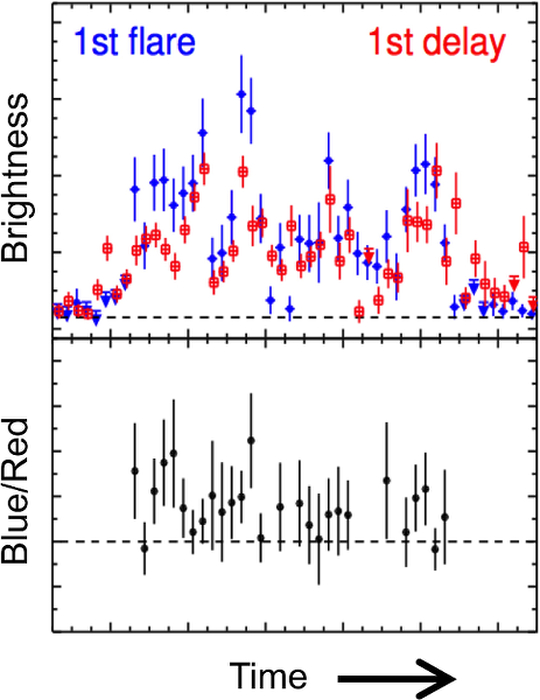
 Credit: C. C. Cheung et al., 2014, The Astrophysical Journal Letters, in press; NASA; DOE
Credit: C. C. Cheung et al., 2014, The Astrophysical Journal Letters, in press; NASA; DOE
Through a Lens Brightly
According to Einstein, matter distorts space and time, like a massive bowling ball placed on a rubber sheet bends the sheet. This distortion alters the flight path of a beam of light, which will deviate around the massive object, so that a single source may appear double, or may be stretched into an arc or a ring. This effect is known as gravitational lensing, and it allows astronomers to accurately determine distributions of matter, and to probe the distant Universe by magnifying the light of faraway objects. Many examples of gravitational lens systems in visible light, and in radio waves, are known. And now astronomers have begun to probe the lensed Universe at Gamma-ray energies, thanks to the sensitivity of the Large Area Telescope on the Fermi Gamma-ray Space Telescope. Using the LAT, astronomers monitored an extremely active galaxy called a blazar. Blazars harbor actively feeding supermassive black holes at their centers, and particle beams generated by the black hole are pointed directly at earth, making for a spectacular fireworks display. The LAT monitored bursts of Gamma-rays from a particular blazar, called B0218+357, during an extremely active phase. B0218+357 also happens to lie behind a spiral galaxy, so that the light from B0218+357 is split apart by the mass of the spiral galaxy, as shown by the Hubble Space Telescope and the Very Large Array radio observatory. Gamma-ray telescopes cannot directly image the small deviation, so the Fermi group tried another tack: to look for time delays in the blazar's Gamma-rays produced by the slightly different paths the Gamma-rays take around the lensing spiral galaxy. The plot above shows evidence that changes in Gamma-ray brightness seem to repeat themselves closely (though not exactly) after about 11 days. The upper plot shows, in blue, a Gamma-ray flare seen by the LAT; in red, the variation in Gamma-rays seen about 11 days afterward. The lower plot shows the ratio of the blue flare to the red one; the dashed line shows the ratio if the flare repeated itself exactly. Astronomers can use this natural lens system, and others, to see where the Gamma-ray emission arises compared to the lower energy optical and radio emission.
Published: January 20, 2014
<
HEA Dictionary ● Archive
● Search HEAPOW
● Other Languages
● HEAPOW on Facebook
● Download all Images
● Education ● HEAD
>

Each week the HEASARC
brings you new, exciting and beautiful images from X-ray and Gamma ray
astronomy. Check back each week and be sure to check out the HEAPOW archive!
Page Author: Dr. Michael F. Corcoran
Last modified Monday, 26-Feb-2024 17:10:25 EST


